Today Eyebury is just a large house to the south of Eye village but in the 14th century it was a busy monastic moated grange & park with deer and cattle roaming the fields under the ownership of Peterborough Abbey. Until the dissolution in the mid 16th century it was one of the occasional residences of the abbots of Peterborough.
Built on a slight rise in the fens it would of been surrounded by marsh with a track or causeway to the south. The only part of the moat that still remains is to the north of the property as most of it has been filled in.
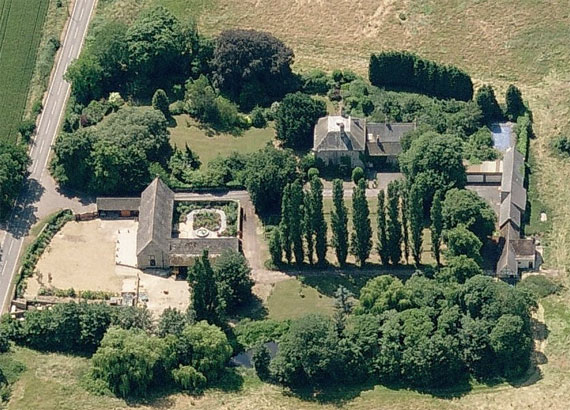
The history of Eyebury began in the 12th Century. Abbot Walter of Bury built a hall which had an upper chapel and a new barn, and surrounded it with a moat and a drawbridge. This lasted over 100 years until Abbott William of Woodford arrived.
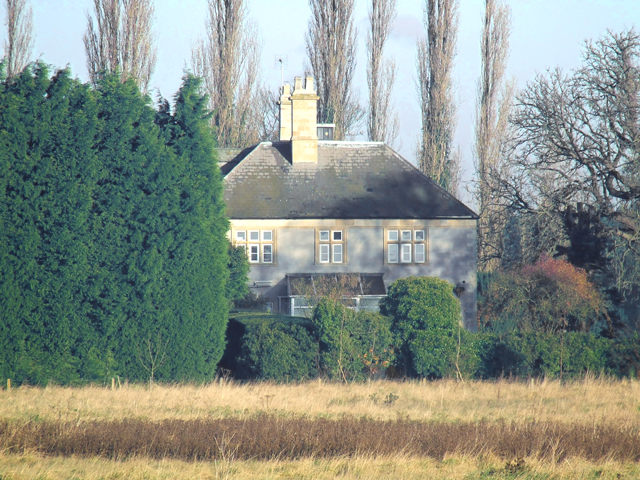 The Abbot William of Woodford constructed a windmill on the siter, and started to build a new hall but it was his successor, the Abbot Godfrey of Crowland, who completed it in 1299. In the first 20 years of the 14th century Godfrey added a cook house, dairy, orchard, game park, replaced the windmill which burnt down, a stable, a large stone barn, dug four fish pools, built a wall around the Garden, added new chambers and offices and last of all in 1315 he added a brew house, lime kiln and poultry house.
The Abbot William of Woodford constructed a windmill on the siter, and started to build a new hall but it was his successor, the Abbot Godfrey of Crowland, who completed it in 1299. In the first 20 years of the 14th century Godfrey added a cook house, dairy, orchard, game park, replaced the windmill which burnt down, a stable, a large stone barn, dug four fish pools, built a wall around the Garden, added new chambers and offices and last of all in 1315 he added a brew house, lime kiln and poultry house.
Known Abbots that have spent time at Eyebury:
- Abbott Walter of Bury (1233-1246)
- Abbot William of Hotoft (1246-1249
- Abbot William of Woodford (1295-1299)
- Abbot Godfrey of Crowland (1299-1321)
- Abbott Adam de Boothy (1321-1338)
- Abbot Henry Morcot 1338
- Abbot William Genge 1405
An inventory of livestock kept at Eyebury in the year 1539 recorded that there were:
- 590 sheep
- 19 oxen
- Five bulls and bulchins
- 18 kine (cows)
- 13 heifers (two years and upwards)
- Eight steeres
- 12 yearling calves
- Four geldings for the saddle.
As part of the dissolution of the monasteries in 1539, Eyebury came under the ownership of the crown and was subsequently let to Sir John Russell, 1st Earl of Bedford.
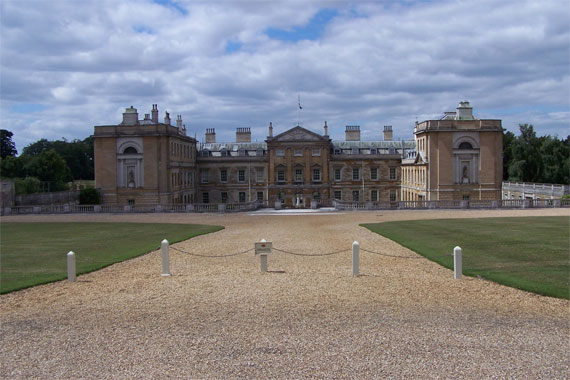
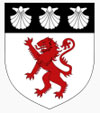 Having entered royal service in about 1506 Sir John Russell served in the army of Henry VIII in France and was knighted for valor in 1522. He enjoyed the privileged position of a Gentleman of the Privy Chamber and was entrusted with many state offices and diplomatic missions. Most of the family estates were granted to him as a reward for these services. The Duke Of Bedford Hall and Duke Of Bedford Primary School are named after him at nearby Thorney.
Having entered royal service in about 1506 Sir John Russell served in the army of Henry VIII in France and was knighted for valor in 1522. He enjoyed the privileged position of a Gentleman of the Privy Chamber and was entrusted with many state offices and diplomatic missions. Most of the family estates were granted to him as a reward for these services. The Duke Of Bedford Hall and Duke Of Bedford Primary School are named after him at nearby Thorney.
The present house at Eyebury was built in the late 17th century. In Eyelife published in 1971 it said that a piece of the old monastic building, an old octagonal column, was holding up a heavy ceiling beam in the cellar. It’s highly likely that much of the monastic old buildings were used to fill in the moat.
In the 18th century its recorded that a Mr John Goude an opulent grazier (meaning wealthy farmer who grazes cattle) was living there.
In 1810 the Leeds family who were originally farmers, came to Eyebury and lived there for over 100 years. The family were famous for the number of fossils they collected from nearby pits. The Leeds Hall in the village is named after them.
John Whitaker Hulke, one of the early pioneers of vertebrate paleontology visited Eyebury on a couple of occasions, this is what he reported on the visit: “In a short visit which I made with Dr Woodward in May 1886 to Eyebury to see the very rich and highly instructive collection of Saurian fossils made by Mr A Leeds from the Kimmeridge Clay of Northamptonshire two series of remains arrested our attention by the close, resemblances they bore to those of the Wealden Ornithopsis, H. G. Seeley, to Omosaurus, R, Owen, and to certain of the American Jurassic Dinosaurs described and figured by Prof O. C. Marsh. We had not at that time with us on the spot the materials for instituting an exhaustive comparison but on a second visit to Eyebury recently made I took with me Sir R Owen’s and Prof O. C. Marsh’s memoirs and with these by me I re-examined the two series of fossils. The results of this renewed inquiry are so interesting that I venture to bring them under the notice of the Geological Society.”

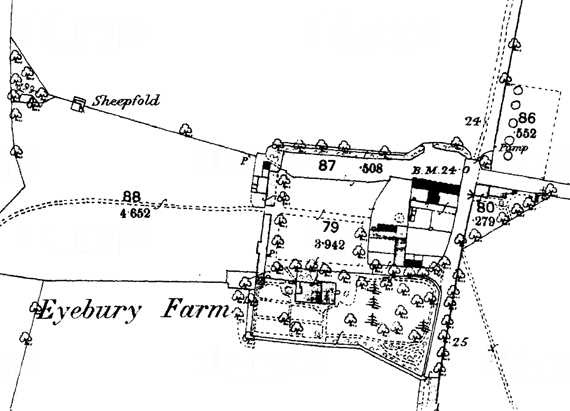
In the 1990’s Eyebury Park (the land to the south and west of the farm) was converted to a members 18 hole, par 70 golf course until financial problems meant it was closed. For a time in early 2000 Peterborough United trained on a football pitch there although it’s now disused and just rough grassland.
Today Eyebury Farm House is privately owned, last sold in 2006 for £499,000 although there is more than one property on the plot.
References
* Wikipedia
* Gentleman’s magazine and historical chronicle, volume 83 January 1798 by John Nichols
* History, Gazette and Directory of Northamptonshire 1849
* The History of the Ancient Abbeys, Monasteries, Hospitals, Cathedral and Collegiate Churches
* The documentary archive of Edward Thurlow Leeds at the Ashmolean Museum

It is stated that the farm was sold in 1917 to a Charles Patson. I can confirm the surname was actually Patston…I knew Jack Patston (presumably the son) very well during the nineteen sixties until his death in, from memory, the early nineties. Jack also farmed at Stibbington, Ayston and Stockerston ( both near Uppingham.) He also had business interests in Huntingdon.
Jack and his wife are buried in Stockerston churchyard.
I was born and brought up in Stockerston, my mother lived there throughout her life, my father farmed there from his marriage until his death in 2003.
Peter
I think you and my Dad Brian Walker are cousins. I am his son Steve and did our family tree years ago and am trying to pick it up a little again. Your father I think was Walter and my grandma was Gladys Walker nee Fryer/Sharp. I am trying to find out about Walter Fryer your grandfather my great grandfather – especially his birthday. Also what events have happened on your side of the family. If you want to get in touch please use the email with this message. Best wishes. Steve
My parents (Alf and Pat Hand) bought the house and farm in 1969 from the Patston family who they knew through the farming community. This was the family home for me from 11years old until I married in 1978. They lived in the main house until 2007 ish then moved into the converted listed barn at the front of the property. My father lived there until his death on May7th 2019.
Dear Val
We have just purchased 2 Eyebury Cottages, Grade II Listed.
We are just about to start extensive renovations to make it into a beautiful home.
We would very much like to more about the cottage and it’s history, but cannot find anything, and wondered if you could perhaps help ?
Thanking you in advance
Hi Paula,
Do you mean the two cottages adjacent to Eyebury House and Eyebury Barn ie over the road? I have limited knowledge of the history of those two cottages but if you’d like to know what I do know, please email me on val_alemanno@yahoo.co.uk. Good luck with the renovations.
Val
My wife, Marie, and I now live at Eyebury Barn. There is a lot to keep us very busy, but we are enjoying our time here.
Hi Mick,
I’m sure there is. My parents moved into The Barn from Eyebury House as the big house was getting too much for them, to be honest it’s not much different size wise ..just a different shape. I hope you’ll be very happy there. I go by both houses a few times a week so remember all the time with my father before he passed away. It’s a great house just needs a bit of tlc. Val
Hi All,
Just been for a last look round for my memories of all the buildings/land/moat from the field adjacent to the moat.
I loved all the buildings of Eyebury Farm especially working with my horse Likely Lad…and he was…in my teenage years.lol
If anyone who has purchased any of the buildings are interested in any of the secrets hidden within and under the main house and it’s gardens…or what The Barn was used for over the years, and ofcourse the Bungalow as I call it but was advertised as the ClubHouse as its been many things over the years lol. You’re more than welcome to contact me.
My name is unusual so Google it and if it’s linked to my book The HorseListener you’ll know you have the right person.
Bye for now,
Val Alemanno
Hi there,
I work in the Geology Department at the Peterborough Museum and Art Gallery. I’ve been researching the the Leeds Brothers and thier achievements for many years. I’m currently working through some historic fossil collections donated by a “Major Leeds” from around 1900 to 1911. If anyone one should have any information about the Leeds family that I might have missed. I’d be very grateful to to hear about it. Especially about any information on the fossils they used to collect.
https://thebigjurassicfish.com/home/alfred-leeds/
We live at Eyebury Barn. We have only been here a little over 3 years but may have some information that you might find helpful. Please make contact.
Hi Mick,
This is wonderful news , I’d certainly like to hear about any information you might have. Sorry about the ridiculous amount of time that has clearly passed with my reply.
Hi Darren,
I’m still going through my parents belongings…an immense load of papers too. If anything crops up I’ll let you know on here.
My contact details are below:-
If i find anything I’ll be in touch.
Val
That’s absolutely wonderful Val, and very much appreciated indeed.
Good evening all,
Just checking in to ask if anyone should have any further information of interest about the Leeds family please. That I could add to the Peterborough Museum and Art Galleries archives.
I haven’t forgotten Darren, still plowing thro my parents papers, photos and cine film.
The only thing I can tell you for sure is that the glass windows on top of Eyebury covered two small ish rooms in part of the attic system…and this is where the Leeds used to show all the skulls, bones and bone pieces in display cases that they found over the years.
Will be in touch if anything else crops up.
Hi Val, has any exciting news materialised as yet please
Hi Darren,
Dont worry, I haven’t forgotten. Still going through hundreds of albums and paperwork. I promise i’ll let you know when…or if i’ve found anything. Val
Hi Val,
Thank you for letting me know
You’re welcome. Val